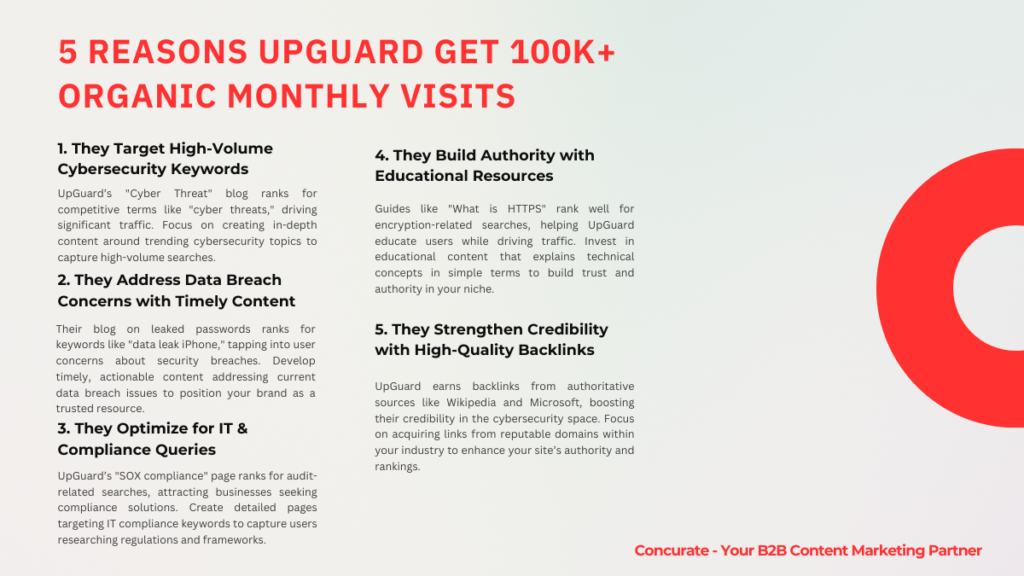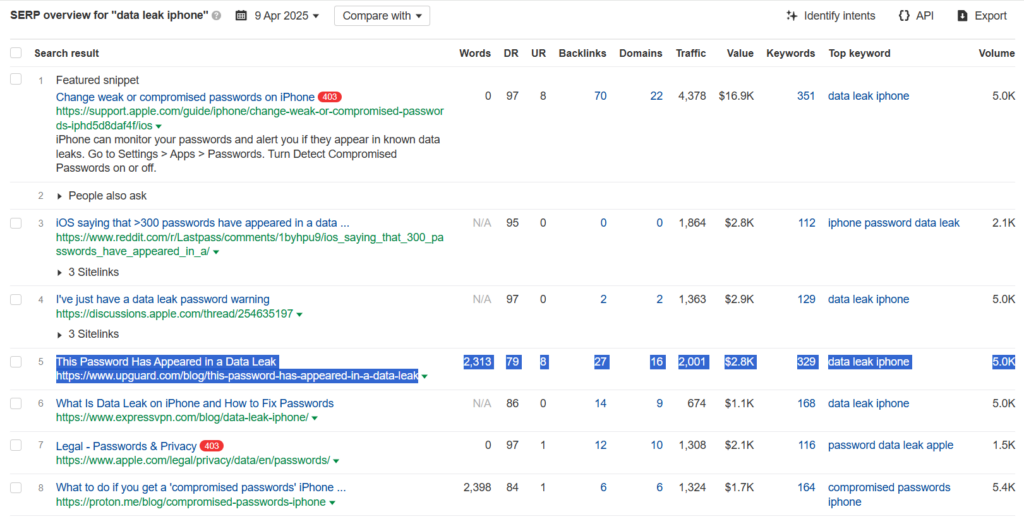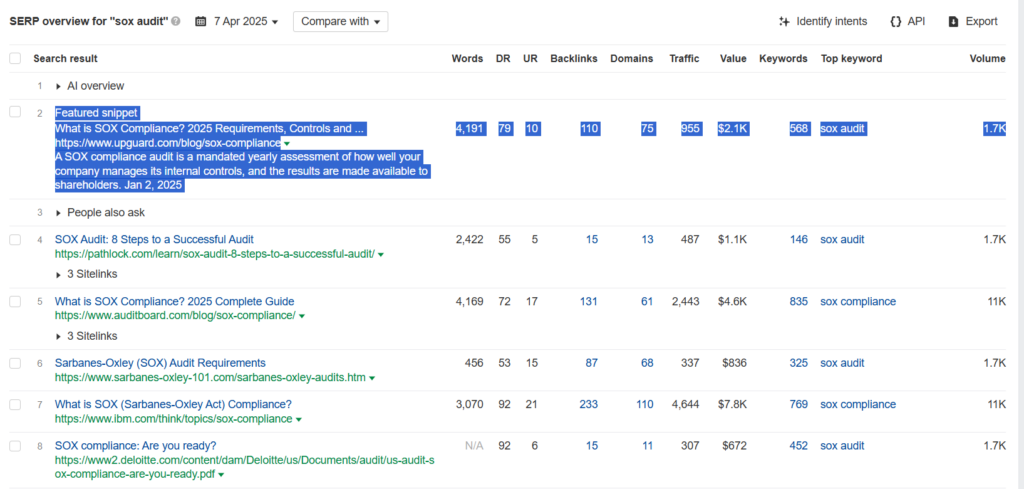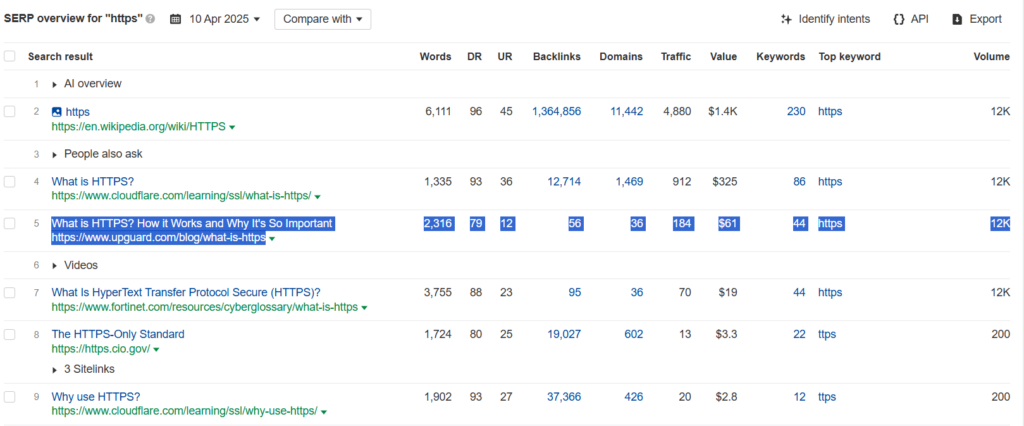Your cybersecurity platform helps businesses sleep better at night.
But your content? It’s practically a ghost town.
You’ve published blogs on third-party risk, compliance checklists, ransomware threats. And still, your content isn’t gaining visibility on search.
Meanwhile, UpGuard ranks #1 for “cyber threats,” pulls 101,000+ organic visits/month, and shows up across every stage of the funnel.
They’ve made SEO their most powerful acquisition channel without running ads, writing clickbait, or chasing fluffy keywords.
In this article, you’ll learn how UpGuard’s content strategy drives high-intent traffic—and how to apply the same plays to your own SEO.
UpGuard’s SEO Snapshot: The Numbers That Matter
| Organic Traffic (Monthly) | 101K |
| Domain Rating (DR) | 79 |
| Backlinks | 69K |
How UpGuard Captures Traffic: Breaking Down the Sources
#1 Branded searches: 27.2K visits (Users already familiar with the brand)
#2 Non-branded searches: 74.3K visits (Capturing users before they know the brand)
#3 Informational searches: 100K visits (Users seeking knowledge and insights)
#4 Navigational searches: 7.4K visits (Users looking for a specific website or page)
#5 Commercial searches: 17.3K visits (Users researching before making a purchase)
Top Pages Driving UpGuard’ Traffic
| Page | Keyword | Position | Monthly Traffic |
| Acronis Homepage | acronis | 1 | 41,910 |
| Acronis True Image (EN) | acronis true image | 1 | 20,613 |
| Acronis True Image (JA) | acronis true image | 1 | 6,545 |
| Acronis Germany | acronis | 1 | 6,298 |
| Acronis Japan Blog – RTO/RPO | rpoとは | 1 | 5,218 |
| Acronis Japan Homepage | acronis | 1 | 5,122 |
| Acronis US Blog – RTO/RPO | rto meaning | 4 | 5,039 |
| Acronis France | acronis | 1 | 4,581 |
| Acronis True Image Support | acronis true image download | 1 | 3,591 |
| Acronis Germany Blog – RTO/RPO | rpo | 1 | 3,563 |
UpGuard’s Top Pages Driving Traffic
#1 The homepage leads the charge, ranking #1 for “UpGuard” and attracting users familiar with the brand.
#2 Cybersecurity insights pull in readers, with the “Cyber Threat” blog ranking for high-volume searches like “cyber threats.”
#3 Data breach concerns drive traffic, as the blog on leaked passwords ranks for “data leak iPhone.”
UpGuard Wins with Search Intent
#1 Security professionals find answers, with “SMB port” and “cybersecurity risk” blogs ranking for critical IT queries.
#2 Compliance seekers turn to UpGuard, as the “SOX compliance” page ranks for searches related to audits and regulations.
#3 Educational content fuels visibility, with the “What is HTTPS” guide capturing users searching for encryption and security terms.
UpGuard’s Backlink Profile: How They Build Authority
| Metric | Value |
| Total backlinks | 69K |
| Referring Domains | 9.9K |
| High-Authority Links | Links from Wikipedia, Telegram, Microsoft |
Insights
#1 UpGuard earns credibility with backlinks from authoritative sources like Wikipedia and Microsoft, signaling strong industry trust.
#2 With 9.9K referring domains, their link-building strategy focuses on breadth, strengthening their presence across multiple sectors.
UpGuard’s Traffic by Location
| Country | Monthly Visits | % of Total Traffic |
| United States | 49.1K | 48.3% |
| India | 17K | 16.8% |
| Australia | 8.9K | 8.8% |
| United Kingdom | 6.3K | 6.2% |
| Canada | 2.5K | 2.5% |
Insights
#1 The U.S. remains UpGuard’s largest traffic source, but a 16.2K drop suggests shifting user interest or rising competition.
#2 India and Australia contribute significant traffic, highlighting strong demand in cybersecurity outside North America.
Traffic Breakdown
| Source | Value |
| Organic Search | 102K |
| Paid Search | 68 |
Rather than relying heavily on paid ads, UpGuard focuses on organic strategies to drive user acquisition; an approach that SaaS brands can leverage to grow without excessive spending.
Paid Ad Keywords That Drive Conversion
UpGuard focuses on specialized cybersecurity terms like “tprm software” and “third-party risk management framework,” indicating a strategy to attract businesses with specific security concerns.
Top Keywords UpGruard Is Bidding On:
#1 “tprm software”
#2 “security compliance questionnaire”
#3 “third party cyber security risk management”
#4 “third-party risk management framework”
#5 “tprm vendors”
#6 “security scorecard reviews”
#7 “vendor verification checklist”
Insights:
#1 Bidding on “security scorecard reviews” suggests an effort to capture users comparing cybersecurity tools, likely competing with rivals like SecurityScorecard and BitSight.
#2 Keywords like “vendor verification checklist” and “tprm vendors” highlight UpGuard’s focus on helping businesses assess and manage third-party risks effectively.
Things To Learn From UpGuard’s SEO Playbook

#1 Target High-Volume Cybersecurity Keywords
UpGuard’s “Cyber Threat” blog ranks for competitive terms like “cyber threats,” driving significant traffic.
Focus on creating in-depth content around trending cybersecurity topics to capture high-volume searches and attract an audience seeking solutions.

What UpGuard Did Right:
● Built a long-form, expertly structured blog that ranks for 2,800+ high-value keywords
● Took a broad topics (“cyber threats”) and delivered unmatched depth, clarity, and real-world relevance
● Attracted backlinks from government domains and top-tier tech media, boosting authority and trust at scale.
SaaS Playbook: Things To Learn
● Use tools like Ahrefs or Semrush to uncover cybersecurity keywords with high intent and low competition (e.g., “cyber threats 2024,” “latest ransomware tactics”)
● Build a 2,000+ word evergreen guide packed with real-world breaches, visuals, and updated threat examples
● Boost visibility with schema markup, FAQ blocks, and optimized headings to win rich snippets
● Distribute through LinkedIn, email newsletters, and industry Slack groups to earn shares and natural backlinks
#2 Address Data Breach Concerns with Timely Content
Their blog on leaked passwords ranks for keywords like “data leak iPhone,” tapping into user concerns about security breaches.

Develop timely, actionable content addressing current data breach issues to position your brand as a trusted resource.
What UpGuard Did Right:
● Published rapid-response blogs on breaking cybersecurity incidents
● Captured long-tail breach queries with exact-match titles and fast-loading pages indexed within hours
● Positioned their blog as the go-to source for real-time breach monitoring and expert-driven analysis
SaaS Playbook: Things To Learn
● Set up real-time alerts (Google Alerts, RSS, threat feeds) for terms like “data breach,” “zero-day exploit,” and “ransomware attack”
● Publish 600–1,000 word “insight-first” blogs within 24–48 hours; mixing expert commentary with news
● Add trust-building callouts: “What CISOs need to know,” “Immediate steps to take,” or “How to harden your systems”
● Link each piece to your threat prevention guides, product pages, or gated playbooks to convert traffic into leads
#3 Optimize for IT & Compliance Queries
UpGuard’s “SOX compliance” page ranks for audit-related searches, attracting businesses seeking compliance solutions.

Create detailed pages targeting IT compliance keywords to capture users researching regulations and frameworks.
What UpGuard Did Right:
● Built a high-converting landing page targeting transactional compliance queries (e.g., “SOX compliance checklist”)
● Structured it with intent-rich sections: audit prep, penalty breakdowns, step-by-step guides
● Linked it to top-of-funnel content like “What is SOX?” and “SOX vs. SOC 2” to boost topical authority and organic visibility
SaaS Playbook: Things To Learn
● Create a standalone, SEO-optimized page for each compliance framework: HIPAA, SOC 2, SOX, PCI, and more
● Structure the page with H2s and schema markup to answer high-intent queries (“Who needs SOX?”, “What’s the penalty for non-compliance?”)
● Include sidebar CTAs like “See how [Your Product] simplifies compliance” to drive qualified leads
● Pitch the pages to legal blogs, IT media, and compliance newsletters to earn high-authority backlinks
Takeaway: Compliance content isn’t just educational; it’s commercial. Own it and convert it.
#4 Build Authority with Educational Resources
Guides like “What is HTTPS” rank well for encryption-related searches, helping UpGuard educate users while driving traffic.

Invest in educational content that explains technical concepts in simple terms to build trust and authority in your niche.
What UpGuard Did Right:
● Created an evergreen explainer that ranks for “what is HTTPS,” “HTTPS vs HTTP,” and “SSL encryption”
● Nailed the balance between clarity and credibility; beginner-friendly, yet authoritative
● Boosted dwell time and shareability with visuals, analogies, and simple language that actually educates
SaaS Playbook: Things To Learn
● Pinpoint 10–20 “cybersecurity 101” queries your ICP is Googling (e.g., “what is endpoint protection,” “TLS vs SSL”)
● Build a rich knowledge hub of evergreen explainers built for rich snippets and long-term SEO wins
● Layer in glossary tooltips, internal CTAs, and downloadable PDFs to drive engagement and lead gen
● Add real authority; assign content authorship to your CISO or Head of Security for trust and credibility
Ready to Turn SEO into a Scalable Growth Engine?
At Concurate, we help cybersecurity and SaaS brands:
● Rank for keywords your buyers actually Google
● Create lead-gen content that drives pipeline; not just pageviews
● Turn your existing blog into a conversion machine
Let’s start with a no-pressure teardown of your current SEO strategy.
We’ll send back 3 custom, actionable plays; no fluff, no sales pitch.
Ready to stop guessing and start growing? Book your free teardown now.
Disclaimer:
This article is an independent analysis based on publicly available data regarding UpGuard’s SEO strategy. It is not endorsed by, affiliated with, or sponsored by UpGuard Inc. All trademarks mentioned are the property of their respective owners.






